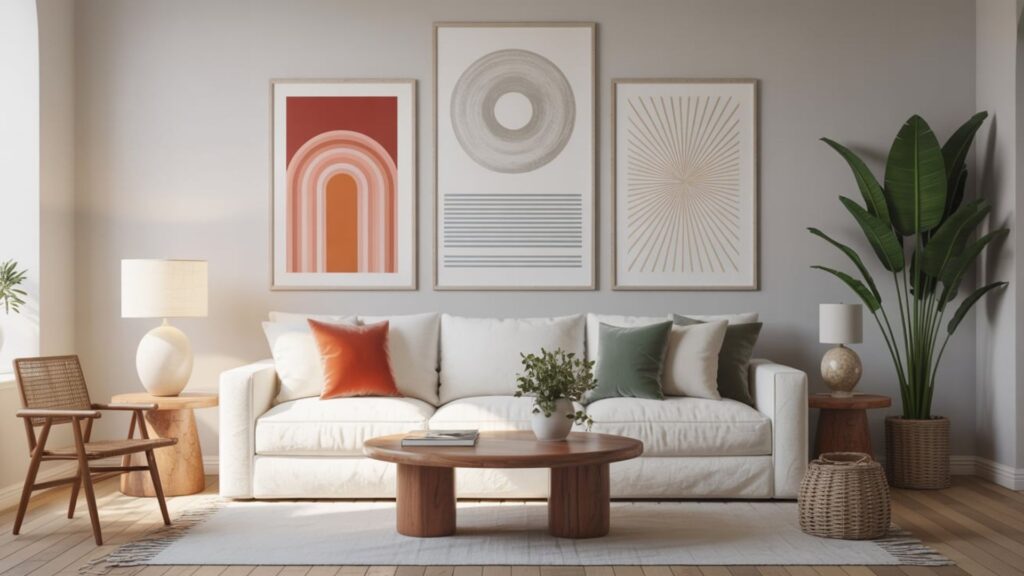I have been, or can be if you click on a link and make a purchase, compensated via a cash payment, gift, or something else of value for writing this post. As an Amazon Associate, I earn from qualifying purchases. Please read my full Affiliate Disclosure for more information.
Craft a layered moments approach by weaving art, textiles, and accessories into one cohesive rhythm that invites touch and guides the eye. Balance color, texture, and scale so pieces converse rather than compete. Let materials mingle—smooth with grain, matte with sheen—for depth you can feel. Arrange with quiet cadence: anchors for visual weight, softer accents for breathing space, and intentional sightlines across rooms. As you layer, memories emerge; keep exploring to uncover more subtle strategies.
Key Takeaways
- Curate cohesive rhythm by pairing art and accessories with balanced color, texture, and scale across surfaces and silhouettes.
- Layer tactile contrasts (smooth vs grain, matte vs sheen) to add depth while ensuring material harmony.
- Use color as a guiding thread, anchoring bold statements with restrained details for a unified palette.
- Create flow across rooms with intentional sightlines, lighting at thresholds, and furniture as punctuation.
- Weave personal narratives through textures and light, including deliberate color pauses to sustain a lived-in layered aesthetic.
Curating Visual Rhythm With Art and Accessories

Curating visual rhythm with art and accessories is about pairing pieces so they breathe together, not compete. You’re balancing color, texture, and scale to create visual harmony across surfaces and silhouettes. Think mixed media as a conversation: a painting, a textile fragment, and a sculptural object nodding to one another without shouting. You’ll measure cadence by spacing, repetition, and focal points that guide the eye gently. The goal is cohesion over clash, a quiet, intentional rhythm you feel as you move through the room. When done well, small details reinforce the whole, inviting touch, curiosity, and calm.
Textures And scale: Layering Materials for Depth
Textures and scale work together to carve depth from surface. You feel how texture and proportion converse, creating a layered map you can read with your hands and eyes. Start with tactile contrast: pair smooth with grain, matte with sheen, soft with structure. The goal is material harmony, where each element supports the next rather than competing for attention. Vary scale thoughtfully—large anchors, smaller voces—so rooms breathe with rhythm. Consider the finish, weight, and fiber origin as cues guiding your eye through the composition. When thoughtfully arranged, textures reveal depth, tactility, and cohesive serenity.
Color Language: Balancing Bold Statements and Quiet Details
Color language is the art of balancing bold statements with quiet details, so a room can speak loudly in one moment and whisper the next. You’ll tune color contrast to guide focus, making architecture feel intentional and rooms feel cohesive. Subtle accents harmonize elements without overpowering them, inviting touch and reflection. Embrace palettes that echo furniture lines, textiles, and art, so every surface reads as part of a single conversation. You’ll test scale, warmth, and texture to avoid visual fatigue, then refine until balance feels inevitable.
- Color contrast as a guiding thread
- Subtle accents across textures
- Quiet details that illuminate form
- Bold statements anchored by restraint
- Palette cohesion across zones
Spatial Storytelling: Arranging Moments Across Rooms
Spatial storytelling unfolds as you move through rooms, guiding moments with flow rather than force. You choreograph sightlines with lighting ambiance that shifts as you traverse thresholds, letting textures meet at each doorway. Consider furniture placement as punctuation: a sofa anchors a conversation, a chair invites a pause, a console hints at arrival. Transitions matter—gradual reveals between spaces, not abrupt changes. Group artworks and textiles to echo a nearby color or texture, stitching rooms into a shared memory. The rhythm is tactile, cohesive, and intelligible, inviting interpretive participation. By sequencing encounters, you craft a coherent narrative that feels inevitable, not assembled.
Everyday Comforts Within a Layered Aesthetic
Everyday comforts thrive when a layered aesthetic embraces you rather than overwhelms you; the space feels soft yet intentional, inviting you to linger.
- personal narrative threads that weave between textures and light
- tactile materials that invite touch and memory
- deliberate color pauses to sustain aesthetic coherence
- balanced scale pairing garments with furniture for quiet rhythm
- intimate rituals embedded in daily routines, systematized yet human
You’ll notice how these elements ground atmosphere without shouting, creating a cohesive whole. Comfort becomes a design discipline: a lived-in story that stays fresh, precise, and accessible.
Conclusion
You’ll feel the room breathe as art, textiles, and accessories converse in quiet, deliberate rhythm. Layering textures invites touched memories, from woven warmth to slick metal gleams. You balance bold statements with subtle whispers, letting color and scale guide each moment across spaces. Everyday comforts become part of the concept, anchoring the narrative in daily life. In this tactile cohesion, you craft a layered moment that reads as a single, evolving room—distinct yet inseparable from you.

Leave a Reply